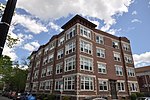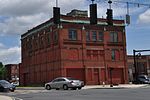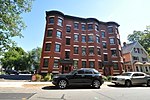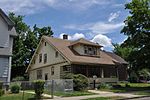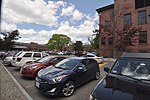St. John's Congregational Church & Parsonage-Parish for Working Girls

The St. John's Congregational Church and Parsonage-Parish for Working Girls are a pair of historic religious buildings at 69 Hancock and 643 Union Streets in Springfield, Massachusetts. The church, built in 1911 for an African-American congregation founded in 1889, is a well-preserved example of English and Gothic Revival architecture. The parsonage, built in 1913, is a little-altered example of Colonial Revival architecture. Both buildings are important in the history of Springfield's African-American community, and were listed on the National Register of Historic Places in 2016. The church building is now occupied by a different congregation, the original having moved to larger quarters across Union Street; the parsonage house continues to be used by the St. John's congregation as an education center.
Excerpt from the Wikipedia article St. John's Congregational Church & Parsonage-Parish for Working Girls (License: CC BY-SA 3.0, Authors, Images).St. John's Congregational Church & Parsonage-Parish for Working Girls
Union Street, Springfield
Geographical coordinates (GPS) Address Nearby Places Show on map
Geographical coordinates (GPS)
| Latitude | Longitude |
|---|---|
| N 42.108055555556 ° | E -72.568611111111 ° |
Address
Union Street 600
01105 Springfield
Massachusetts, United States
Open on Google Maps

